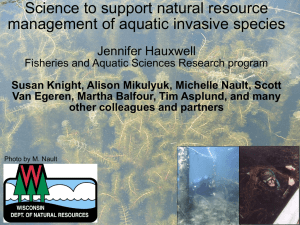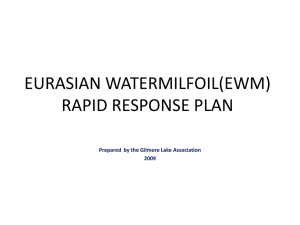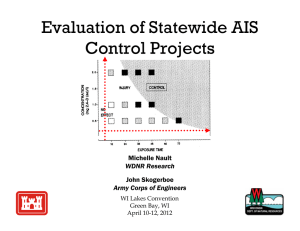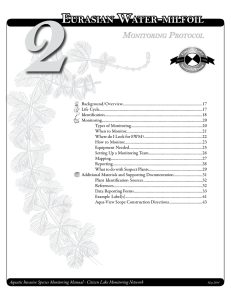Invasive Aquatic Plant Management in WI: Are we making a difference?
advertisement
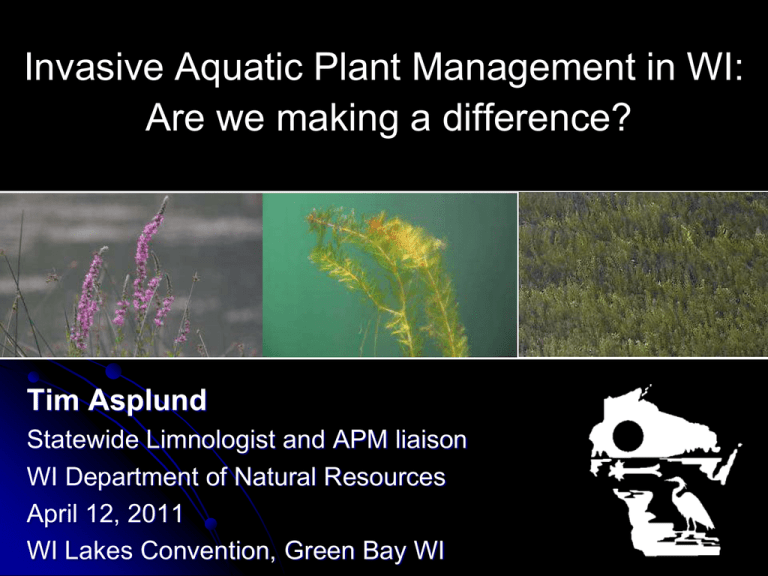
Invasive Aquatic Plant Management in WI: Are we making a difference? Tim Asplund Statewide Limnologist and APM liaison WI Department of Natural Resources April 12, 2011 WI Lakes Convention, Green Bay WI Littoral Frequency of Occurrence of EWM Littoral Frequency of Occurrence = # of sites with EWM # sites shallower than the maximum depth of plant colonization . X100 n = 146 Wisconsin’s Aquatic Invasive Plant Strategy Aquatic Invasive Species Grants $4 million/year as of July 1, 2008 State provides up to 75% cost share New research and demonstration category Since 2004: Over $8 million in prevention and planning projects for the development of integrated management plans, boating inspection and education projects. $1,200,000 in early detection and response projects to curtail spread and provide follow up monitoring, planning and prevention. Approximately $5 million for chemical, biological and mechanical control of established AIS Aquatic Plant Management Plan Goals & Objectives Lake Information Analysis Alternatives Recommendations Implementation Monitoring & Evaluation http://www.uwsp.edu/cnr/uwexlakes/ecology/APMguide.asp Post-treatment monitoring and evaluation (compliance) Aquatic plant surveys (treatment effectiveness and native impact/response) Dissolved oxygen (negative impacts on DO levels from decaying vegetation) Water quality (clarity, chl a, TP, pH, etc: algal response to nutrients released from decaying vegetation or less competition from macrophytes) Residuals (effectiveness of treatments and safety thresholds) Ongoing AIS Research Long-term EWM dynamics EWM and CLP treatment efficacy Residual monitoring Weevil study Smart Prevention Improving communication strategies Wisconsin DNR 2005-2006 Research Results 100 lakes survey (25% of EWM lakes statewide) Heavy Management EWM Littoral Frequency of Occurrence (%) 100 Light Management 80 No Management 60 40 20 0 0 10 20 30 40 50 Years Since Initial Detection Any management approach can result in wide variation in current EWM 24 Lake Long-term EWM Management Study -How does strategic management affect long-term EWM population levels? Annual aquatic plant survey and biomass collection on 24 lakes over time 3 ecoregions, established and new populations, managed and unmanaged Ongoing Treatment Evaluations US Army Corps of Engineers Sandbar & Tomahawk Lake, Bayfield Co. Turville Bay, Lake Monona, Dane Co. Half Moon Lake, Eau Claire Eagle Lake, Racine Co Eagle River Chain, Vilas Co. Town of Phelps lakes Legend Lake Kettle Moraine Lake, FdL Co. Loon Lake, Shawano Co Partnerships with MN and MI Wisconsin DNR Objectives & Approach Significantly reduce area infested with Eurasian water milfoil Protect the native aquatic plant community density and diversity Long term, whole lake management of aquatic plant communities (3-5 years) Early season, low dose treatment methodology Persistence and concentration of herbicides are being monitored in order to evaluate both effectiveness and risks 2010 Herbicide Residual Sampling, 25 lakes •Monona, Dane •Half Moon, Eau Claire •Loon, Shawano •Kettle Moraine, Fond du Lac •Big Sand Vilas •Long, Vilas •South Twin, Vilas •Eagle River Chain (3), Vilas •Little St Germaine, Vilas •Frog, Iron •Eagle, Racine •Jordan, Portage US Army Corps of Engineers •Metonga, Forest •Minocqua, Oneida •Kawaquesaga, Oneida •Tomahawk, Oneida •Bridge, Oneida/Lincoln •Mohawksin, Lincoln •Connors, Sawyer •Lower Spring, Jefferson •Kathan, Oneida •Enterprise, Langlade •English, Manitowok Engineer Research and Development Center Preliminary Findings Small-scale spot treatments have limited longterm effectiveness due to rapid dissipation Early spring, large scale treatments in northern lakes may result in longer persistence of herbicides than expected Application approach must be tailored to the site – label guidelines are not adequate Residual monitoring is important, both to understand treatment efficacy, as well as ecological risks 2,4-D Concentration/Exposure Time 2000 1500 1000 500 J. Aquat. Plant Manage 30: 1-5 2,4-D Whole Lake Treatments Mean Lake Wide 2,4-D Concentration, 0 to 7 Days, Effects on 2 Eurasian Watermilfoil Control, R = 0.70 100 Half Moon, 09 Big Sand, 10 Percent Control (%) 90 Tom ahaw k, 10South Tw in, 10 Data Model Scattering Rice, 10 Kathan, 10 80 Bridge, 10 Lower Spring, 10 70 60 No control 50 ??? South Tw in, 09 Seasonal control 40 30 20 10 Big Sand, 09 0 Langford, 09 0 100 Damage to some natives 200 Focus area High level of control English, 10 Frog, 10 Damage to natives 300 400 500 600 Mean 2,4-D Concentration J. Skogerboe, ACOE and M. Nault, WDNR http://dnr.wi.gov/org/es/science/publications/SS_1074.pdf Northern Lakes & Forests Unmanaged Managed Kathan Sandbar Tomahawk Bear Paw Connors Little Bearskin Manson Silver 7 Island Arrowhead Hancock Southeastern Till Plains Unmanaged Managed Gibbs Ivanhoe L. Green Wingra Turtle Kettle Moraine Short-term Results for EWM Long-term Results for EWM? Short- and Long-term for Natives? Short- and Long-term Economic Costs? Are we making a difference? Is it worth it? If so, what have been the keys to success? If not, why not? What could be improved? These questions can be answered from the perspective of 1) Pure cost ($$) 2) Management effort 3) Ecological net benefit Can we sustain this over time? Panel Discussion Wayne Towne, Legend Lake Brad Roost, Cason and Associates Dan Anderson, Long Lake, Vilas Co. Tim Hoyman, Onterra, Inc Kevin Gauthier, WDNR lake coordinator Are we making a difference? Is it worth it? If so, what have been the keys to success? If not, why not? What could be improved? These questions can be answered from the perspective of 1) Pure cost ($$) 2) Management effort 3) Ecological net benefit Can we sustain this over time? Looking forward Can we sustain this effort over time in terms of funding, volunteers, technical support? Are the potential risks to native plants, people, or aquatic life acceptable? Should the State be spending grant money on a smaller number of projects where we know we can be successful in the long term, or spread the money out to as many projects as possible? How much should we invest in monitoring and evaluating new techniques? Food for thought • What are the upsides of whole-lake treatments? • What are the downsides of whole-lake treatments? • What are the costs of not managing on a lake-wide scale? • If we can get populations below 10% of the lake area, do our management options change? Food for thought • When we start treating, how much effort for how long will we need to keep the population in check? • What happens when we stop managing? • When does the scale tip? • Who decides what level of effort lakes SHOULD pursue? Food for thought • Are there certain situations that should be managed with higher priority? • What would we gain from a coordinated regional containment versus lake by lake shielding effort? • What are the costs of not managing on a landscape or regional scale?




